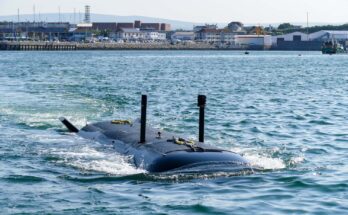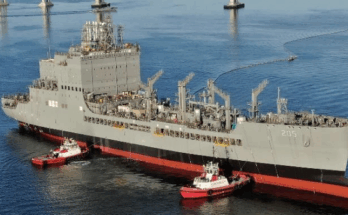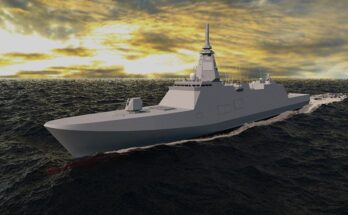by Stuart Slade, Senior Naval & Marine Power Systems Analyst, Forecast International.
The Norwegian frigate Helge Ingstad has been beached and abandoned following a collision with an oil tanker in the Hjeltefjord near Bergen, Norway, in the early hours of Thursday, November 8. The ship was severely damaged in the collision with the tanker Sola TS, suffering a massive gash along one side. The torn area appears to extend a quarter of the ship’s length, leaving the machinery spaces open to the sea. The severity of the damage was made clear when the crew of 137 was forced to abandon ship, and the ship was beached to prevent her sinking in the shipping lane and blocking access to Equinor’s Sture oil shipment terminal nearby. The terminal has been closed as a precautionary measure.
Recent pictures show the frigate listing dangerously even before she was beached; she became grounded while still approximately upright. More recent pictures posted on the Internet show her rolled over on to her starboard side and sinking by the stern. The tanker Sola TS was only slightly damaged and appears not to have spilled any oil. However, one report suggested that despite suffering only superficial damage, the tanker is now at a standstill and waiting to be towed into a Norwegian port.
It is not immediately clear what caused the collision, which took place around 0300 GMT when the KNM Helge Ingstad was returning from NATO military exercises. The frigate’s AIS (Automatic Identification System) tracking system was turned on only after the collision occurred. Thus, the relative courses of the two ships are difficult to determine. The Norwegian Navy reported at a press conference Thursday afternoon that it is not uncommon for warships to sail without AIS to avoid highlighting their position, and rejected this as an explanation for the accident. It is worth noting that Norwegian warships have an anti-collision system that triggers an alarm if other vessels are on a collision course. One might presume that bridge lookouts are supposed to do the same thing.
According to local sources reported in the Norwegian newspaper Aftenposten, the “situation has gone from bad to worse,” and only skilled and heroic actions by local tugboats prevented the frigate from capsizing and sinking. Recent video shows the tugs pushing the wrecked frigate solidly on to the rocks, not something one would do to a ship if there was any hope of saving her.
Photographs of the wreck posted on Twitter show an enormous slash extending at least a quarter of the ship’s length along her starboard side, abreast of her machinery spaces. The underwater damage is not immediately obvious; but based on experience with two U.S. Navy destroyers involved in collisions earlier this year, the bulbous bow now fitted to nearly all merchant ships, including the Sola TS, is responsible for the most serious damage. The extent of the above-water damage implies that the injury to the Helge Ingstad is dire indeed.
Beaching a ship is the last desperate action taken to prevent her immediate loss. The fact that the Helge Ingstad was beached means that the situation on board was far beyond critical. The only option may be to write her off as a constructive total loss (CTL). When controlling damage from a collision of this sort, the first step is to establish a “flooding perimeter,” a ring of locked and sealed watertight doors around the damage that stops water from spreading throughout the hull. Failure to establish a flooding perimeter means that water can spread in a phenomenon known as “progressive flooding.” Once progressive flooding starts, it is almost impossible to stop since water has an uncanny ability to find paths through even the best-built ships.
The continuously worsening state of the ship reported by eye witnesses and the obvious, extensive damage to the hull suggest that progressive flooding on board is out of control. This means that the ship’s electronic systems are now severely compromised—a situation that on its own brings the frigate close to being a CTL. It is significant that Norwegian statements on the ship’s condition are becoming more pessimistic. In fact, it appears that the Helge Ingstad is likely a total loss and that present efforts are aimed more toward preventing environmental damage from oil released by the ship’s fuel tanks than saving the frigate. There are already some reports of minor oil slicks being spotted in the Hjeltefjord.
The Helge Ingstad is an F85 class frigate, one of five built by Navantia in Spain. She was delivered in 2009. The frigate was built around a local-defense variant of the AEGIS combat management system. The crew is small for a ship of this size and complexity, which is already leading to questions over whether crew reductions had been taken too far. Assuming the ship is a CTL, the issue of her replacement will be a blow to Norwegian naval planning. A replacement will probably cost in the region of $800 million.
Stuart Slade is currently the primary analyst for Forecast International’s Warships Forecast and Industrial & Marine Turbine Forecast. He is the author of United States Strategic Bombers 1945-2012, Littoral Warfare: Ships and Systems, Navies in the Nuclear Age and Multinational Naval Operations. In addition, he has been a regular contributor on the subjects of warships technology, military electronics, and naval systems to a number of leading journals.
For 50 years, Forecast International intelligence reports have been the aerospace and defense industry standard for accurate research, analysis, and projections. Our experienced analysts compile, evaluate, and present accurate data for decision makers. FI's market research reports offer concise analysis of individual programs and identify market opportunities. Each report includes a program overview, detailed statistics, recent developments and a competitive analysis, culminating in production forecasts spanning 10 or 15 years. Let our market intelligence reports be a key part of reducing uncertainties and mastering your specific market and its growth potential. Find out more at www.forecastinternational.com




